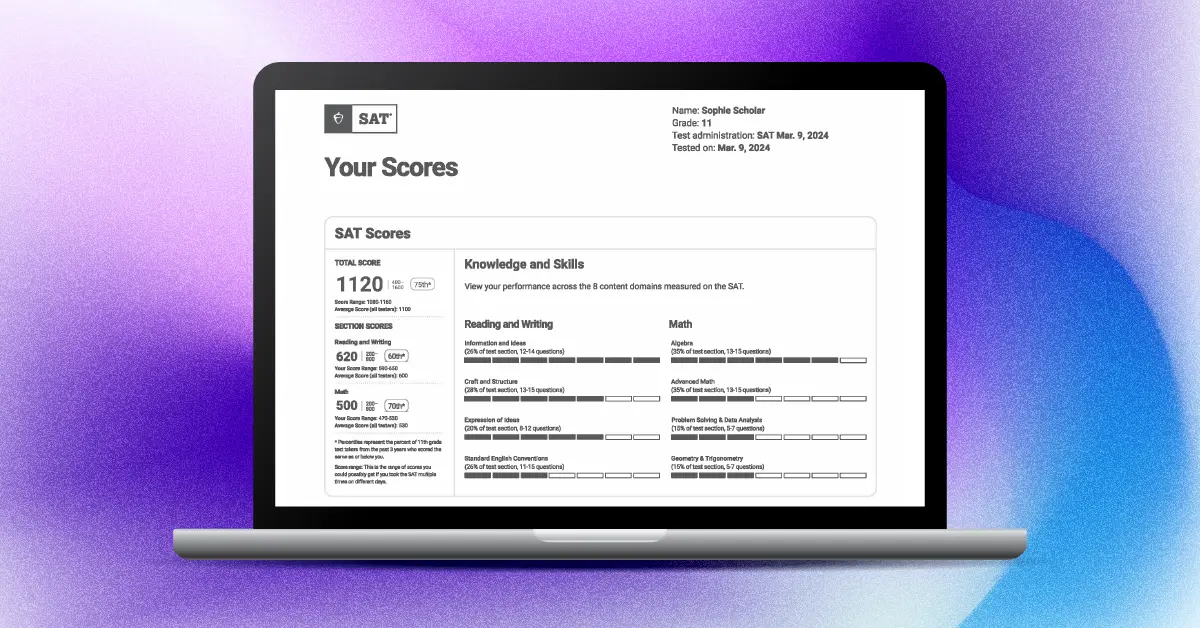When creating an SAT® test preparation schedule, it can be difficult to know where to begin and how to maximize your time spent studying. Here is a breakdown of some tips you can utilize when creating your study plan.
Consider how setting goals, finding your weak points, understanding the structure of the test, practicing the skills that are necessary for success, and tracking your improvement can benefit you as you prepare for the official SAT exam.
1. Set Goals
Before you can create an SAT prep schedule or organize a study plan, you must know what your goal score is. This will be different for everyone. You should set your goals based on your research about each school you’re applying to.
Look into the scores that resulted in acceptances in recent years, and decipher a scoring threshold to aim for. You can set goals for each of the three SAT sections but you do not need to divide your total goal score evenly among the Reading, Writing, and Math exams.
If you are more confident in your math skills, you may weigh your goals for that section heavier. Unless you are shooting for a perfect score on the SAT exam, there is likely some wiggle room for the number of questions you can get wrong on each section of the exam.
Set goals in accordance with your skills and the expectations of the schools that you hope to get acceptance letters from.
2. Find Weak Points and Areas To Improve
Once you have set your goals for each sub-section of the exam and determined a total score that you are reaching towards, you can take a practice test and find weak points that you need to improve in order to reach your goals.
Finding your weak points is also a great way to streamline your study plan and ensure that you maximize your time effectiveness. With so much on your plate in the months leading up to college applications, you must manage your time well.
If you take a practice exam and find that you perform well above your goals for the Math exam but need to improve your scores in the Writing test, you should weigh your study time heavier on the areas you need to improve the most. Avoid wasting time and focus on studying your weaker performance areas.
3. Understand the Structure of the Test
Once you have set goals and determined the areas you hope to improve the most through studying and practice work, it is a good idea to spend some time assessing and understanding the structure of the SAT exam.
The details about question types, subsections, formats, data representations, passage styles, and more are important to know.
A big part of your preparation is knowing what to expect. Recognizing specific question types or passage types may allow you to make predictions about the concepts or skills being tested by that specific question or passage.
When building the study plan, be sure that you take time to evaluate the exam format, not only on a macro scale but on a micro scale as well. The little details are just as important as the big picture factors when it comes to knowing what to expect.
4. Practice Your Skills
As you prepare for the SAT exam, consider how to divide your time between studying and practicing. It is one thing to be able to memorize concepts, but it is important that you are also able to apply the skills and understandings that you learn in your studies to your practice work. It is important to find a balance between your study work and practice work.
5. Practice the Entire Exam and Reassess Areas of Improvement
Something you should consider when building a study plan is scheduling time to take full-length practice exams. It can be easy to get caught up in the details of the test, but the best way to track your improvement is by taking an entire practice exam and evaluating your score report.
You don’t need to take an entire practice test each time you study for the SAT. Instead, consider working on the details then coming back to a full-length test to assess your progress. These full-length practice tests are also a great way to ensure that you have a realistic understanding of testing fatigue, distractions, and other factors that may disrupt your ability to perform.
As you build your study plan and create a prep schedule for the SAT test, consider following these steps to ensure that you maximize your time spent practicing and studying for the exam. As you work, you may consider using UWorld’s SAT Prep Course, which offers thousands of realistic test questions, performance tracking tools, and detailed question explanations. Try it out to ensure that your practice work is as realistic as possible.
You should also know that the performance tracking tools offered by UWorld’s SAT prep course are very effective for pinpointing your weak points and tracking your progress throughout your studies and practice.
You can use the detailed question explanations offered by the prep course to learn from your mistakes and deepen your understanding of more complicated problems or concepts.




